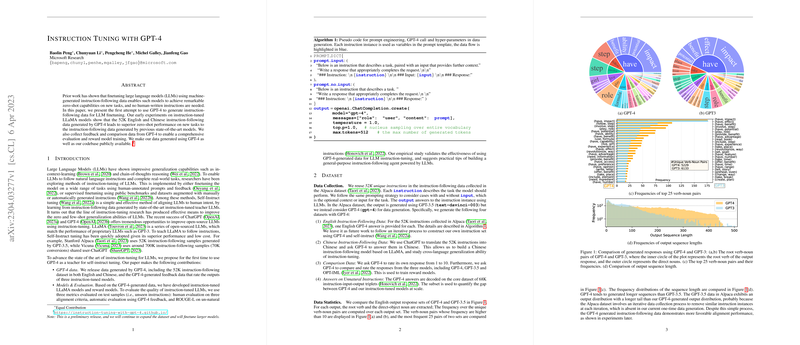Instruction Tuning with GPT-4
The paper, "Instruction Tuning with GPT-4," presents a robust exploration into the enhancement of LLMs using instruction-following data generated by GPT-4. The focus is on fine-tuning these models without relying on human-written instructions, advancing previous methodologies that utilized machine-generated data for instruction tuning.
Key Contributions
This research introduces the application of GPT-4 as a data generation tool for instruction tuning, showcasing several significant achievements:
- Data Generation: The authors release a dataset consisting of 52,000 English and Chinese instruction-following instances created by GPT-4. This dataset is crucial for the instruction tuning of the LLaMA models.
- Empirical Evaluation: The paper provides a thorough evaluation of instruction-tuned LLaMA models against models trained with earlier GPT data, demonstrating superior zero-shot performance on novel tasks.
- Feedback Mechanism: Feedback data generated by GPT-4 is employed to enhance comprehensive evaluation and reward model training, aiming to push the boundaries of model alignment with human instruction-following intent.
Methodology
The research leverages a multi-faceted approach to augment LLM capabilities:
- Instruction-Tuning: Models like LLaMA are fine-tuned using GPT-4 generated data, exhibiting improved performance over previous models trained with GPT-3.5 data, as exemplified by the Alpaca project.
- Cross-Language Evaluation: By translating tasks into Chinese and generating corresponding instruction-following data, the paper explores cross-language generalization capabilities.
- Reward Model Training: The research harnesses GPT-4's intrinsic feedback capabilities, training reward models through rating scheme comparisons involving GPT-3.5, GPT-4, and other LLMs.
Experimental Insights
The paper employs a series of evaluations to substantiate the efficacy of its approach:
- Human Evaluation: Utilizing alignment criteria such as Helpfulness, Honesty, and Harmlessness, GPT-4-instruction-tuned LLaMA models are assessed alongside their precursors, consistently demonstrating enhanced alignment.
- Automatic Evaluation: By engaging GPT-4 to evaluate response quality across multiple models, it is evidenced that LLaMA instruction-tuned with GPT-4 matches closely with GPT-4 itself, surpassing prior instruction-tuned models.
- Benchmark Performance: The models are tested on comprehensive benchmarks, with LLaMA-GPT4 often outperforming Alpaca and even the original LLaMA. This highlights the promise of GPT-4 generated instructions in realigning model capabilities towards unseen tasks.
Conclusion and Implications
This paper provides compelling evidence that GPT-4 can serve as a potent source for generating high-quality instruction-following data, which, when used for tuning LLMs, can substantially enhance their performance in zero-shot contexts. The released datasets and code ensure that these findings can support ongoing development in the field, encouraging the evolution of LLMs.
The implications of this research are significant, particularly for open-source LLM development, pointing towards a future where these models can be finely tuned to follow instructions with enhanced precision and generalization capabilities. Future advancements may focus on integrating reinforcement learning from human feedback (RLHF) further into training regimes and scaling datasets and models to unlock even greater potential in LLM instruction tuning.
